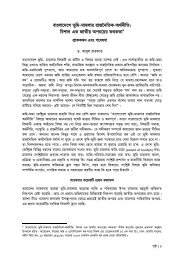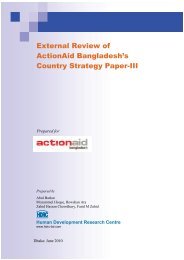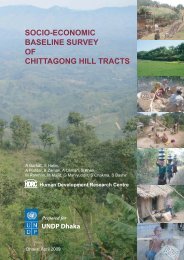08. Costing Essential Services Package An Issue Paper
08. Costing Essential Services Package An Issue Paper
08. Costing Essential Services Package An Issue Paper
You also want an ePaper? Increase the reach of your titles
YUMPU automatically turns print PDFs into web optimized ePapers that Google loves.
<strong>Costing</strong> <strong>Essential</strong> <strong>Services</strong> <strong>Package</strong>: <strong>An</strong> <strong>Issue</strong> <strong>Paper</strong> 24<br />
<strong>Issue</strong>s of Concern Responses<br />
is not recorded; this makes expenditure lower than actual. These unpaid debts,<br />
according to the expert must be included in the full cost. Some experts argued that<br />
to calculate financial sustainability, full cost (economic cost) is essential.<br />
Conduction of special surveys is proposed by some respondents.<br />
6. <strong>An</strong>nualization In the HPSP, life cycle of all ESP equipment is assumed to be 5 years. One<br />
suggested approach is to estimate the useful life of each durable item and<br />
annualize before aggregating inputs. <strong>An</strong>other expert opined that proper<br />
annualization helps to minimize gap between budget and actual expenditure.<br />
7. Commodity<br />
costing/<br />
pricing<br />
8. Full cost<br />
calculation,<br />
quality service<br />
delivery<br />
(particularly ESP<br />
delivery),<br />
<strong>An</strong>nual lapses in<br />
achieving<br />
targets (physical<br />
and financial)<br />
9. Followup-action<br />
and followupmechanism<br />
of<br />
innumerable<br />
studies and<br />
workshops in<br />
Health and<br />
Family Welfare<br />
Sector.<br />
The bottom-up commodity costs shows that many of the supplies are disease<br />
specific, some of the supplies and a lot of the equipment have common use across<br />
sub-components of the ESP. Regarding relation between commodity utilization and<br />
work-pattern, it was argued that in the HPSP, with more commodities sub-optimal<br />
patterns of work is not guaranteed to change sufficiently to proper utilization of<br />
these commodities.<br />
Some respondents were critical about the concept of full costing of ESP as they<br />
think full costing would be cumbersome, complex and not often needed from the<br />
point of financing from public exchequer. Unforeseen costs involvement including<br />
social costs, costs for preparatory work (such as workshops, meetings, retreat etc.)<br />
need not be highlighted to calculate the full costs of ESP. A few other respondents<br />
thought that delineation of non-ESP costs from ESP costs (unit cost) is not easy,<br />
rather difficult. In cost calculations, assumptions and the principle of rule of thumb<br />
were convenient and close to reality. However, most of the respondents agreed that<br />
full costs calculation of ESP components (unit-wise) is a necessity at preappraisal/appraisal<br />
stage; the full knowledge must be there about full costs, so that<br />
options and choices in terms of opportunity costs (economic costs) can be<br />
judiciously exercised. Then a very few respondents raised the question of value of<br />
ESP costing in view of penalty of fund and delayed release/availability of fund<br />
causing serious set-back to achieving the targets as laid down in the <strong>An</strong>nual<br />
Operational Plan (AOP). They think, once you mis the Bus you can hardly reach<br />
the destination, no matter how efficient a Line Director might be. He is helpless,<br />
and for no fault of his own he is struck up in the system, and a desirable change in<br />
the system would be time consuming because attitudinal and behavioral change<br />
cannot be accomplished in quick steps.<br />
Some respondents during one-to-one discussion raised the issue of systematic<br />
action for follow-up of activities generated from innumerable workshops and<br />
seminars for which crores of taka are spent annually from the public exchequer.<br />
Respondents were of the view that not only large amount of hard cash is spent but<br />
“time” of a huge number of personnel are spent which is never costed, though<br />
opportunity cost of Taka spent could even be larger than the “hard cash”.<br />
Workshop resolutions, seminar recommendations remain in paper and are<br />
forgotten, except in few cases where sporadic efforts are seen. It was strongly felt<br />
that follow-up action in a systematic way should be sustained and a follow-up<br />
mechanism, not simply a “committee” mechanism, be instituted, and if necessary<br />
capable, dependable outside agencies may be engaged for facilitating follow-up<br />
action stage-by-stage. A few respondents said that while the review process for<br />
methodological improvement in ESP costing should continue, and if necessary, pilot<br />
projects undertaken, the existing estimates of costing ESP need not to be<br />
overruled, rather fund should be made available to meet the estimated needs of<br />
ESP service delivery.






